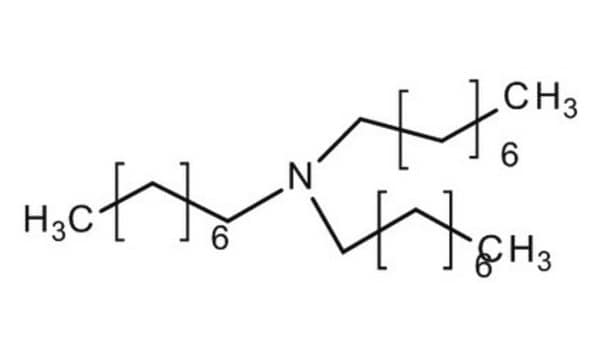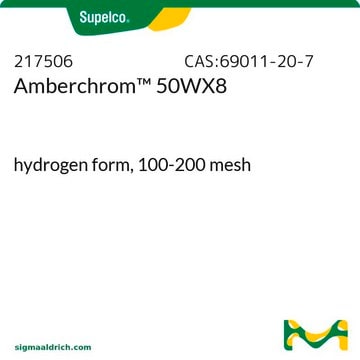471313
Tributylamine
≥98.5%
Sinónimos:
Tri-n-butylamine
About This Item
Productos recomendados
vapor density
6.38 (vs air)
Quality Level
vapor pressure
0.3 mmHg ( 20 °C)
2.4 mmHg ( 55 °C)
assay
≥98.5%
form
liquid
autoignition temp.
410 °F
expl. lim.
6 %
refractive index
n20/D 1.428 (lit.)
pH
10.2 (25 °C, 0.1 g/L)
bp
216 °C (lit.)
mp
−70 °C (lit.)
density
0.778 g/mL at 25 °C (lit.)
SMILES string
CCCCN(CCCC)CCCC
InChI
1S/C12H27N/c1-4-7-10-13(11-8-5-2)12-9-6-3/h4-12H2,1-3H3
InChI key
IMFACGCPASFAPR-UHFFFAOYSA-N
¿Está buscando productos similares? Visita Guía de comparación de productos
General description
Application
- An extraction solvent with CHCA (α-cyano-4-hydroxycinnamic acid) for the selective phospholipids (PLs) extraction from EVOO (extra virgin olive oil) and HO (hazelnut oil).
- A hydroxylating agent in the synthesis of spinel nickel ferrites (NiFe2O4) nanoparticles (NPs).
Features and Benefits
signalword
Danger
hcodes
Hazard Classifications
Acute Tox. 1 Inhalation - Acute Tox. 2 Dermal - Acute Tox. 4 Oral - Skin Irrit. 2
Storage Class
6.1A - Combustible acute toxic Cat. 1 and 2 / very toxic hazardous materials
wgk_germany
WGK 1
flash_point_f
145.4 °F - closed cup
flash_point_c
63 °C - closed cup
Certificados de análisis (COA)
Busque Certificados de análisis (COA) introduciendo el número de lote del producto. Los números de lote se encuentran en la etiqueta del producto después de las palabras «Lot» o «Batch»
¿Ya tiene este producto?
Encuentre la documentación para los productos que ha comprado recientemente en la Biblioteca de documentos.
Los clientes también vieron
Nuestro equipo de científicos tiene experiencia en todas las áreas de investigación: Ciencias de la vida, Ciencia de los materiales, Síntesis química, Cromatografía, Analítica y muchas otras.
Póngase en contacto con el Servicio técnico











